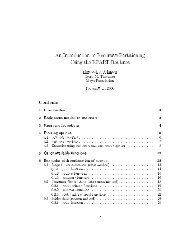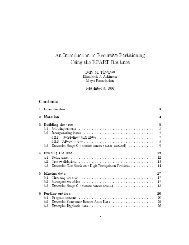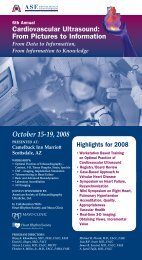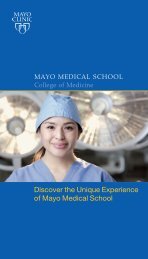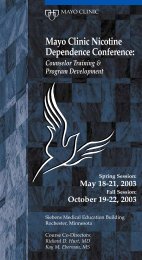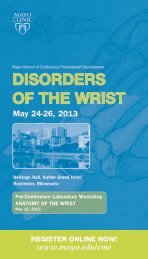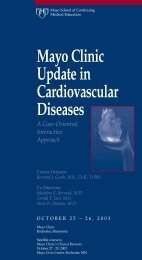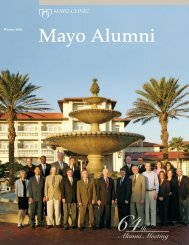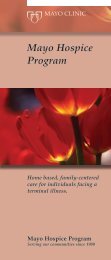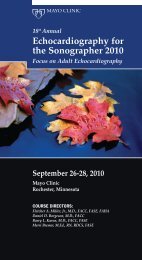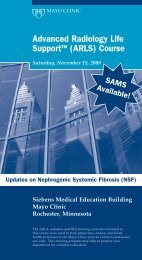Mayo Alumni Magazine 2002 Spring - MC4409-0402 - Mayo Clinic
Mayo Alumni Magazine 2002 Spring - MC4409-0402 - Mayo Clinic
Mayo Alumni Magazine 2002 Spring - MC4409-0402 - Mayo Clinic
You also want an ePaper? Increase the reach of your titles
YUMPU automatically turns print PDFs into web optimized ePapers that Google loves.
sample. Because each DNA copy<br />
serves as a template for producing<br />
yet another copy of DNA with each<br />
heating and cooling cycle, the<br />
amount of DNA is increased<br />
exponentially, so eventually there is<br />
enough DNA available to run further<br />
tests on it. In the final step, the<br />
amplified DNA is probed for<br />
evidence of the organism’s presence.<br />
Historically, each of these steps has<br />
required hours to complete.<br />
Speeding up PCR technology<br />
Jim Uhl, a member of the<br />
microbiology team that<br />
developed the rapid anthrax<br />
test, demonstrates how the<br />
device works.<br />
“We spend a great deal of our time<br />
searching the genomes of microorganisms,”<br />
says Dr. Cockerill.<br />
“Humans evolved from these<br />
organisms and some of their DNA is<br />
the same as ours. So we need to find<br />
their fingerprints — unique segments<br />
of DNA that specifically identify them.”<br />
The second step incorporates PCR<br />
technology — using an enzyme called<br />
Taq polymerase to copy the DNA. This<br />
chemical reaction is repeated 30 to 40<br />
times by heating and cooling the<br />
The key to producing a rapid PCR<br />
test was the development of a new<br />
technology, trademarked as the<br />
LightCycler, and its application to<br />
clinical microbiology diagnostic<br />
testing. It was a feat that evolved<br />
from international, multidisciplinary<br />
collaboration between its inventor,<br />
Carl Wittwer, Ph.D., a University of<br />
Utah chemist with an engineering<br />
background; researchers at<br />
Boehringer Mannheim, a Bavarian<br />
chemistry plant that later merged<br />
with the Swiss company Roche<br />
Applied Science; and the <strong>Mayo</strong><br />
microbiology team.<br />
<strong>Mayo</strong> <strong>Clinic</strong> was the first<br />
institution in the United States to use<br />
the LightCycler when, in February<br />
1998, the microbiology team procured<br />
it for a 30-day trial. Roche Applied<br />
Science was marketing the tool to<br />
research laboratories, but Lester<br />
Wold, M.D., chair of the Department<br />
4 <strong>Mayo</strong> <strong>Alumni</strong> <strong>Spring</strong> <strong>2002</strong>



